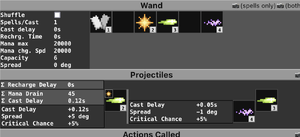Tool: Noita Wand Simulator
The Noita Wand Simulator, created by salinecitrine, is a tool that will construct the spell evaluation tree for any sequence of spells you can come up with. If you're confused about what your wand is doing plugging it into the Simulator will likely help you clear things up.
Here's the link: https://noita-wand-simulator.salinecitrine.com
The current development version (which includes support for the current Noita beta, but may be less stable) can be found here: https://tinker-with-wands-online.vercel.app See Tool: Noita Wand Simulator/beta for more information.
Wands on the Wiki
You can use the {{Wand}} and {{Wand Card}} wiki templates to display Wands in wiki articles. These include a link to the Simulator to examine and modify the design.
There are many examples in the Expert Guide series, and the Simulator includes them as presets. If you find yourself confused by an example, or just want to look at the tree, hit the presets button in the top right and select the example you're working with. From there, you can see how it's all working, and even switch things around to see what would happen if things were different. Spell mechanics get very technical at a certain point, so doing this is a great way to check your understanding.
User Guide
Basic Usage
Drag and drop spells from the palette at the top into slots on the wand below, the simulation updates automatically as you edit. The Projectiles section shows what is emitted by the wand, split by cast and casting group.
Configuration
The Configuration menu allows you to alter Simulator behaviour. These settings are stored in your web browser and will persist for the next time you use the tool. Note especially the 'unlock' option - which by default hides a lot of spells that require in-game unlocks.
- Combine Similar Actions - Hides repeated actions under the 'actions called' view, showing a count of the repeats instead.
- Unlimited Spells - corresponds to the perk, check to make most spells unlimited. (Note: limited use spells are currently not simulated, and are considered to have zero uses left.)
- Infinite Spells - does the same as Unlimited, but for all spells, including those not affected by the perk.
- Show Direct Action calls - Actions are the function spells do when they're cast, some spells can call other spells' actions directly (e.g. Divide By). This setting controls whether you see these in the Actions Called view.
- Show Divides - Show or hide the Divide By spells in the Actions Called view.
- Show Greek Spells - Show or hide the Greek spells in the Actions Called view.
- Show Deck Indexes - Show or hide the numbers showing which slot of the wand the spell is from.
- Show Recursion and Iteration - Shows the Recursion (blue) level a recursive spell has reached, and the Iteration (purple) level of a Divide By spell.
- Show Projectile Proxies - Some spells (e.g. Add Trigger) create a new spell based on an existing spell's projectile. This option shows you which spell 'proxied' such a projectile.
- Show Action Sources - The small D or A symbol in the lower-left of the spell icons. D = Drawn, A = direct Action.
- Show Don't Draw - the small red D symbol in the upper-left of the spell icons. This indicates that draw has been disabled during the execution of the associated spell.
- Swap When Moving Actions - Moving spells around on the Wand works as it does in the game, turn this option off if you want to replace dragged onto spells without swapping them.
- Show Action Tree - toggle display of the Action Tree section.
- Show Spells in Categories - switch on/off spell categories in the palette.
- End Simulation on Wand Refresh - stop simulating the cast sequence after Wand Refresh would have caused it to end. Typically you want to leave this one on.
Examples
Develop
Tool: Noita Wand Simulator/beta
The Simulator is an open project and welcomes ideas, code contributions, etc. (and especially bug reports!) Have a look at the GitHub repository for more information.

